TANG CHINA DYNASTY (618–906) CONNECTION: Vajrabodhi (671–741) was an Indian Hindu) Buddhist monk
and esoteric Buddhist teacher in Tang China. He spent most of his time in ritual activity,
in translating texts from Sanskrit to Chinese. |
SOURCE:
Chin-kang-ting-yu'ch'ieh chung liieh ch'u nien-sung ching (The Vajrasekhara Sutra, also known as the Sarvatathagatatattvasmgraha) |
http://www.shingon.org/teachings/Shi...ngochoKyo.html
Politics and Transcendent Wisdom: The Scripture for Humane Kings
in the Creation of Chinese Buddhism (Hermeneutics)
By Dr Charles D. Orzech (1998)
Hardcover ISBN: 978-0-271-01715-0
Paperback ISBN: 978-0-271-02836-1 |
#Book source:
https://www.amazon.co.uk/Politics-Tr.../dp/0271017155
Dr Charles D. Orzech: email:
Charles.Orzech@glasgow.ac.uk |
Vajrabodhi was the second of three Vajrayana missionaries to eighth-century China. He was born of a South Indian brahmin family, and his father was a priest for the royal house. | Leaving India, Vajrabodhi traveled to Sri Lanka and Srivijaya (present-day Sumatra), where he apparently was taught a Vajrayana tradition distinct from that taught at Nalanda. From Srivijaya he sailed to China via the escort of thirty-five Persian merchant-vessels, and by AD 720 was ensconced in the Jianfu Temple at the Chinese capital, Chang'an (present-day Xian). Accompanying him was his soon-to-be-famous disciple, Amoghavajra.|
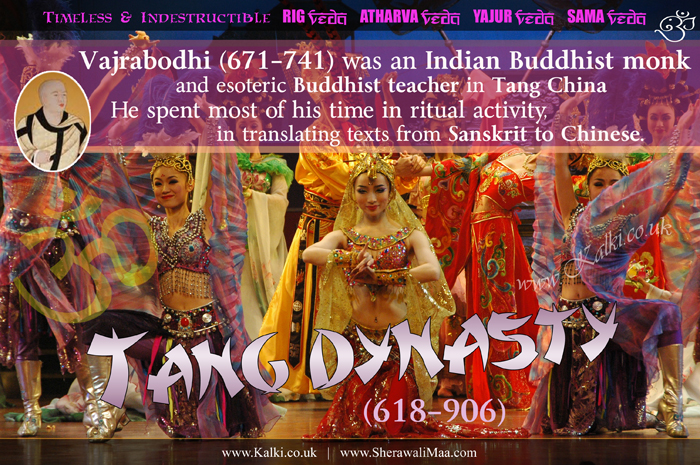
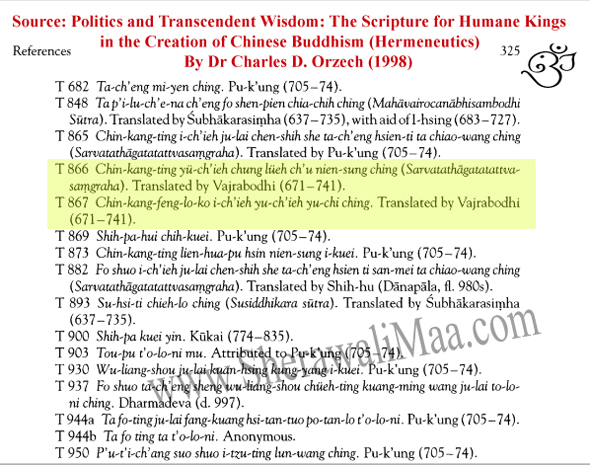
TANG CHINA DYNASTY (618–906) BUDDHIST CONNECTION: Amoghavajra (705-774) was a prolific translator who became one of the most politically powerful Buddhist monks in Chinese history and is acknowledged as one of the Eight Patriarchs of the Doctrine in Shingon Buddhism. | Born in Samarkand of an Indian father and Sogdian mother, he went to China at age 10 after his father's death. In 719, he was ordained into the sangha by Vajrabodhi and became his disciple. After all foreign monks were expelled from China in 741, he and some associates went on a pilgrimage to gather texts, visiting Sri Lanka, Indochina and India. During this voyage, he apparently met Nagabodhi, Vajrabodhi's master, and studied the Tattvasaṃgraha Tantra at length. He returned to China in 746 with some five hundred volumes. |
www.SherawaliMaa.com
TATTVASAMGRAHA TANTRA ~ TAISHO TRIPITAKA ~ TANG CHINA DYNASTY (618–906) CONNECTION: PAGE EXTRACT - SOURCE:
Filial Piety in Chinese Thought and History By Alan Chan, Sor-Hoon Tan (2012)
ISBN-10: 0415647770
ISBN-13: 978-0415647779
https://www.amazon.co.uk/Filial-Piet.../dp/0415647770
| (Tattvasamgraha Tantra) Taisho Tripitaka, abbreviated to: T.866 was translated into Chinese by Vajrabodhi (671–741) was an Indian Buddhist monk
and esoteric Buddhist teacher in Tang China. | Amoghavajra (705-774) was a prolific translator who became one of the most politically powerful Buddhist monks in Chinese history and is acknowledged as one of the Eight Patriarchs of the Doctrine in Shingon Buddhism. | Amoghavajra (705-774) Born in Samarkand of an Indian father and Sogdian mother, he went to China at age 10 after his father's death. In 719, he was ordained into the sangha by Vajrabodhi and became his disciple. After all foreign monks were expelled from China in 741, he and some associates went on a pilgrimage to gather texts, visiting Sri Lanka, Indochina and India. During this voyage, he apparently met Nagabodhi, Vajrabodhi's master, and studied the Tattvasaṃgraha Tantra at length. He returned to China in 746 with some five hundred volumes. |
www.SherawaliMaa.com
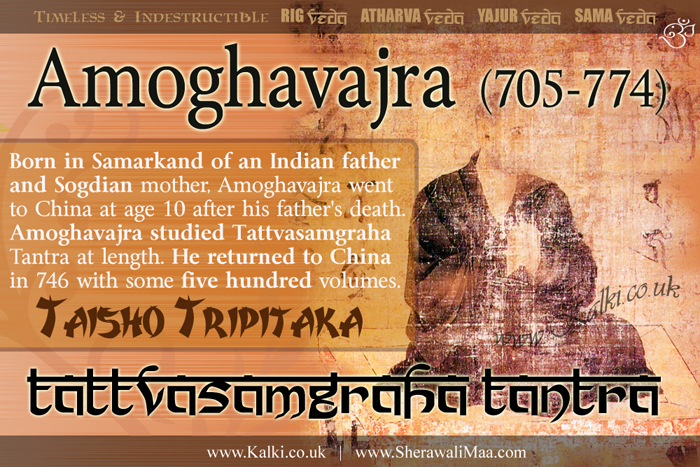
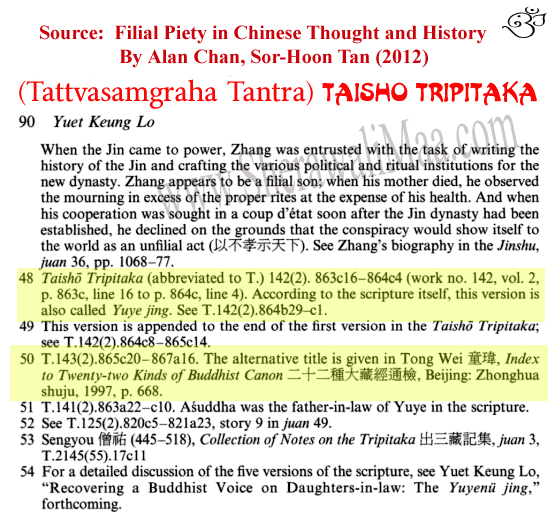
TANG CHINA DYNASTY (618–906) CONNECTION:
Subhakarasimha (637-735) was an eminent
Indian Buddhist monk and master of Esoteric Buddhism,
who arrived in the Chinese capital Chang'an (now Xi'an) in 716 CE and translated the Mahavairocana Abhisambodhi
Tantra, better known as the Mahavairocana Sutra.
| 'By the end of the century, the stage had been set for the introduction of so-called pure Tantric Buddhism.
The Indian Tantric master Subhakarasimha (sha-wu-wei, 637-735) and his Chinese disciple I-hsing (683-727)
transmitted the Mahavairocana Sutra. Vajrabodhi (Chin-kang-chih, 671-741), and his disciple, Amoghavajra (Puk-k'ung, 705-774) introduced texts of Vajrasekhara line.
These men were responsible for bringing Tantric Buddhism to its height of popularity in china.' |Buddhist Sects and Sectarianism By Bibhuti Baruah - January 1, 2000 / Mar. 2008 |
ISBN-10: 8176251526
ISBN-13: 978-8176251525 |
www.SherawaliMaa.com
TANG CHINA DYNASTY (618–906) CONNECTION:
'By the end of the century, the stage had been set for the introduction of so-called pure Tantric Buddhism.
The Indian Tantric master Subhakarasimha (sha-wu-wei, 637-735) and his Chinese disciple I-hsing (683-727)
transmitted the Mahavairocana Sutra. Vajrabodhi (Chin-kang-chih, 671-741), and his disciple, Amoghavajra (Puk-k'ung, 705-774) introduced texts of Vajrasekhara line.
These men were responsible for bringing Tantric Buddhism to its height of popularity in china.' |
Subhakarasimha (637-735) was an eminent
Indian Buddhist monk and master of Esoteric Buddhism,
who arrived in the Chinese capital Chang'an (now Xi'an) in 716 CE and translated the Mahavairocana Abhisambodhi
Tantra, better known as the Mahavairocana Sutra.
| Buddhist Sects and Sectarianism By Bibhuti Baruah - January 1, 2000 / Mar. 2008 |
ISBN-10: 8176251526
ISBN-13: 978-8176251525 |
www.SherawaliMaa.com
https://www.amazon.co.uk/Buddhist-Se.../dp/8176251526
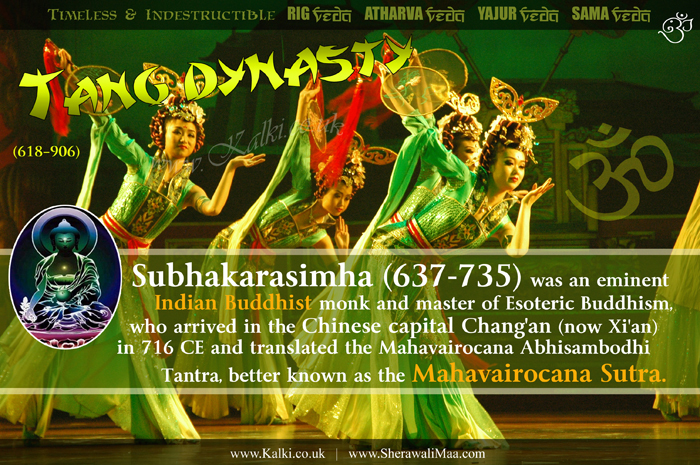
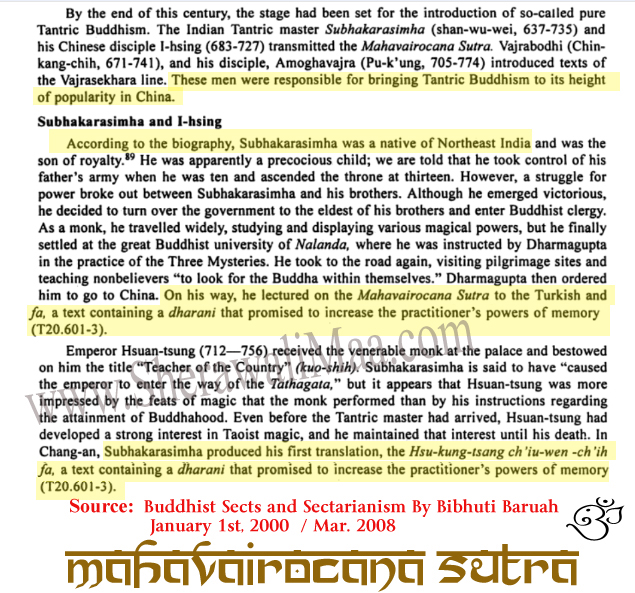
#Rituals #Hinduism #Hindu #Bharat
#India #Vedas #AumShantiAum #BhagavadGita #HenryDavidThoreau #Yoga #Meditation #philosophy #philosopher #essayist #Poet #America #Physics #Science #QuantumField #BrianJosephson
#electrons #Physicist #Vedanta #Yoga #Spirituality #Religion #Atomic #Cambridge #KimberlySnyder #History #Quantummechanics #QuantumHindu #China #Chess #Grammar #ArabianNights #Arabia #Algebra #Boccaccio #Goethe #Herder #Schopenhauer #Emerson #Aesop #trigonometry #literature #Religion #Islam #Islamic #Sikhism #Arabs #Arabia #Atheism #Greeks #China #LinYutang #Vajrabodhi #Amoghavajra #Subhakarasimha #Mahavairocana #Tattvasaṃgraha #Samarkand #ShingonMikkyo #TangDynasty #Chinese #China #SriLanka